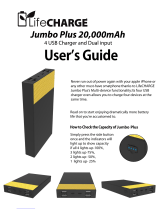
2
Usage and Safety Precautions
In this operation manual, symbols are used to highlight
warnings and cautions that you must read to prevent
accidents. The meanings of these symbols are as follows.
Something that could cause serious injury
or death.
Something that could cause injury or
damage to the equipment.
Other symbols used
An action that is mandatory.
An action that is prohibited.
Warnings
Operation using an AC adapter
Always use an AC adapter that is 9V DC 500mA center negative
(ZOOM AD-16).
Do not do anything that could exceed the ratings of outlets and
other electrical wiring equipment.
Before using the equipment in a foreign country or other region
where the electrical voltage differs, always consult with a shop
that carries ZOOM products and use the appropriate AC adapter.
Operation with batteries
Use 2 commercially-available 1.5V AA batteries (alkaline or nick-
el metal hydride).
Carefully study the warning indications of the batteries before
use.
Always keep the battery cover closed during use.
Alterations
Do not open the case or modify the product.
Cautions
Product handling
Do not drop, bump or apply excessive force to the unit.
Be careful not to allow foreign objects or liquids to enter the
unit.
Operating environment
Do not use in extremely high or low temperatures.
Do not use near heaters, stoves and other heat sources.
Do not use in very high humidity or where it could be splashed
by water.
Do not use in places with frequent vibrations.
Do not use in places with much dust or sand.
AC adapter handling
When disconnecting the power plug from an outlet, always pull
on the plug itself.
Disconnect the power plug from the outlet when the unit will
not be used for a long time and whenever there is lightning.
Battery handling
Install batteries with the correct +/− orientations.
Use the specied batteries.
Do not use new and old batteries together. Do not use batteries
of different brands or types together.
Interference with other electrical equipment
In consideration of safety, the has been designed
to minimize its emission of electromagnetic waves and to
suppress interference from external electromagnetic waves.
However, equipment that is very susceptible to interference
or that emits powerful electromagnetic waves could result in
interference if placed nearby. If this occurs, place the
and the other device farther apart.
With any type of electronic device that uses digital control,
including the
, electromagnetic interference could
cause malfunction, corrupt or destroy data and result in other
unexpected trouble. Always use caution.
Cleaning
Use a soft cloth to clean the exterior of the unit if it becomes
dirty. If necessary, use a damp cloth that has been wrung out
well to wipe it.
Never use abrasive cleansers, wax or solvents such as alcohol,
benzene or paint thinner.
Breakdown and malfunction
If the unit becomes broken or malfunctions, immediately turn
the power off, disconnect the AC adapter and disconnect other
cables. Contact the store where you bought the unit or ZOOM
service with the following information: product model, serial
number and specific symptoms of breakdown or malfunction,
along with your name, address and telephone number.
Safety Precautions
Usage Precautions
Remove the batteries when the unit will not be used for a long
time.
If a leak occurs, thoroughly wipe the battery case and battery
terminals to remove the leaked uid.
Connection cables and input/output jacks
Always turn the power OFF for all equipment before connecting
any cables.
Always disconnect all connection cables and the AC adapter
before moving the unit.
Volume
Do not use at a loud volume for a long time.
Declaration of Conformity
For EU Countries
FCC regulation warning (for U.S.A.)
Note: This equipment has been tested and found to comply with
the limits for a Class B digital device, pursuant to Part 15 of the FCC
Rules. These limits are designed to provide reasonable protection
against harmful interference in a residential installation. This
equipment generates, uses and can radiate radio frequency energy
and, if not installed and used in accordance with the instructions,
may cause harmful interference to radio communications. However,
there is no guarantee that interference will not occur in a particular
installation. If this equipment does cause harmful interference to
radio or television reception, which can be determined by turning
the equipment off and on, the user is encouraged to try to correct
the interference by one or more of the following measures:
• Reorient or relocate the receiving antenna.
• Increase the separation between the equipment and receiver.
•
Connect the equipment into an outlet on a circuit different from
that to which the receiver is connected.
• Consult the dealer or an experienced radio/TV technician for help.




















